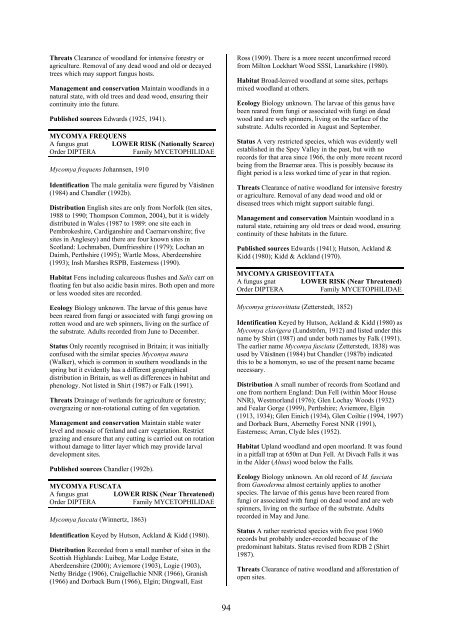Part 2: Nematocera and Aschiza not dealt with by Falk (1991) - JNCC
Part 2: Nematocera and Aschiza not dealt with by Falk (1991) - JNCC
Part 2: Nematocera and Aschiza not dealt with by Falk (1991) - JNCC
You also want an ePaper? Increase the reach of your titles
YUMPU automatically turns print PDFs into web optimized ePapers that Google loves.
Threats Clearance of woodl<strong>and</strong> for intensive forestry or<br />
agriculture. Removal of any dead wood <strong>and</strong> old or decayed<br />
trees which may support fungus hosts.<br />
Management <strong>and</strong> conservation Maintain woodl<strong>and</strong>s in a<br />
natural state, <strong>with</strong> old trees <strong>and</strong> dead wood, ensuring their<br />
continuity into the future.<br />
Published sources Edwards (1925, 1941).<br />
MYCOMYA FREQUENS<br />
A fungus gnat LOWER RISK (Nationally Scarce)<br />
Order DIPTERA<br />
Family MYCETOPHILIDAE<br />
Mycomya frequens Johannsen, 1910<br />
Identification The male genitalia were figured <strong>by</strong> Väisänen<br />
(1984) <strong>and</strong> Ch<strong>and</strong>ler (1992b).<br />
Distribution English sites are only from Norfolk (ten sites,<br />
1988 to 1990; Thompson Common, 2004), but it is widely<br />
distributed in Wales (1987 to 1989: one site each in<br />
Pembrokeshire, Cardiganshire <strong>and</strong> Caernarvonshire; five<br />
sites in Anglesey) <strong>and</strong> there are four known sites in<br />
Scotl<strong>and</strong>: Lochmaben, Dumfriesshire (1979); Lochan an<br />
Daimh, Perthshire (1995); Wartle Moss, Aberdeenshire<br />
(1993); Insh Marshes RSPB, Easterness (1990).<br />
Habitat Fens including calcareous flushes <strong>and</strong> Salix carr on<br />
floating fen but also acidic basin mires. Both open <strong>and</strong> more<br />
or less wooded sites are recorded.<br />
Ecology Biology unknown. The larvae of this genus have<br />
been reared from fungi or associated <strong>with</strong> fungi growing on<br />
rotten wood <strong>and</strong> are web spinners, living on the surface of<br />
the substrate. Adults recorded from June to December.<br />
Status Only recently recognised in Britain; it was initially<br />
confused <strong>with</strong> the similar species Mycomya maura<br />
(Walker), which is common in southern woodl<strong>and</strong>s in the<br />
spring but it evidently has a different geographical<br />
distribution in Britain, as well as differences in habitat <strong>and</strong><br />
phenology. Not listed in Shirt (1987) or <strong>Falk</strong> (<strong>1991</strong>).<br />
Threats Drainage of wetl<strong>and</strong>s for agriculture or forestry;<br />
overgrazing or non-rotational cutting of fen vegetation.<br />
Management <strong>and</strong> conservation Maintain stable water<br />
level <strong>and</strong> mosaic of fenl<strong>and</strong> <strong>and</strong> carr vegetation. Restrict<br />
grazing <strong>and</strong> ensure that any cutting is carried out on rotation<br />
<strong>with</strong>out damage to litter layer which may provide larval<br />
development sites.<br />
Published sources Ch<strong>and</strong>ler (1992b).<br />
MYCOMYA FUSCATA<br />
A fungus gnat LOWER RISK (Near Threatened)<br />
Order DIPTERA<br />
Family MYCETOPHILIDAE<br />
Mycomya fuscata (Winnertz, 1863)<br />
Identification Keyed <strong>by</strong> Hutson, Ackl<strong>and</strong> & Kidd (1980).<br />
Distribution Recorded from a small number of sites in the<br />
Scottish Highl<strong>and</strong>s: Luibeg, Mar Lodge Estate,<br />
Aberdeenshire (2000); Aviemore (1903), Logie (1903),<br />
Nethy Bridge (1906), Craigellachie NNR (1966), Granish<br />
(1966) <strong>and</strong> Dorback Burn (1966), Elgin; Dingwall, East<br />
Ross (1909). There is a more recent unconfirmed record<br />
from Milton Lockhart Wood SSSI, Lanarkshire (1980).<br />
Habitat Broad-leaved woodl<strong>and</strong> at some sites, perhaps<br />
mixed woodl<strong>and</strong> at others.<br />
Ecology Biology unknown. The larvae of this genus have<br />
been reared from fungi or associated <strong>with</strong> fungi on dead<br />
wood <strong>and</strong> are web spinners, living on the surface of the<br />
substrate. Adults recorded in August <strong>and</strong> September.<br />
Status A very restricted species, which was evidently well<br />
established in the Spey Valley in the past, but <strong>with</strong> no<br />
records for that area since 1966, the only more recent record<br />
being from the Braemar area. This is possibly because its<br />
flight period is a less worked time of year in that region.<br />
Threats Clearance of native woodl<strong>and</strong> for intensive forestry<br />
or agriculture. Removal of any dead wood <strong>and</strong> old or<br />
diseased trees which might support suitable fungi.<br />
Management <strong>and</strong> conservation Maintain woodl<strong>and</strong> in a<br />
natural state, retaining any old trees or dead wood, ensuring<br />
continuity of these habitats in the future.<br />
Published sources Edwards (1941); Hutson, Ackl<strong>and</strong> &<br />
Kidd (1980); Kidd & Ackl<strong>and</strong> (1970).<br />
MYCOMYA GRISEOVITTATA<br />
A fungus gnat LOWER RISK (Near Threatened)<br />
Order DIPTERA<br />
Family MYCETOPHILIDAE<br />
Mycomya griseovittata (Zetterstedt, 1852)<br />
Identification Keyed <strong>by</strong> Hutson, Ackl<strong>and</strong> & Kidd (1980) as<br />
Mycomya clavigera (Lundström, 1912) <strong>and</strong> listed under this<br />
name <strong>by</strong> Shirt (1987) <strong>and</strong> under both names <strong>by</strong> <strong>Falk</strong> (<strong>1991</strong>).<br />
The earlier name Mycomya fasciata (Zetterstedt, 1838) was<br />
used <strong>by</strong> Väisänen (1984) but Ch<strong>and</strong>ler (1987b) indicated<br />
this to be a homonym, so use of the present name became<br />
necessary.<br />
Distribution A small number of records from Scotl<strong>and</strong> <strong>and</strong><br />
one from northern Engl<strong>and</strong>: Dun Fell (<strong>with</strong>in Moor House<br />
NNR), Westmorl<strong>and</strong> (1976); Glen Lochay Woods (1932)<br />
<strong>and</strong> Fealar Gorge (1999), Perthshire; Aviemore, Elgin<br />
(1913, 1934); Glen Einich (1934), Glen Coiltie (1994, 1997)<br />
<strong>and</strong> Dorback Burn, Abernethy Forest NNR (<strong>1991</strong>),<br />
Easterness; Arran, Clyde Isles (1952).<br />
Habitat Upl<strong>and</strong> woodl<strong>and</strong> <strong>and</strong> open moorl<strong>and</strong>. It was found<br />
in a pitfall trap at 650m at Dun Fell. At Divach Falls it was<br />
in the Alder (Alnus) wood below the Falls.<br />
Ecology Biology unknown. An old record of M. fasciata<br />
from Ganoderma almost certainly applies to a<strong>not</strong>her<br />
species. The larvae of this genus have been reared from<br />
fungi or associated <strong>with</strong> fungi on dead wood <strong>and</strong> are web<br />
spinners, living on the surface of the substrate. Adults<br />
recorded in May <strong>and</strong> June.<br />
Status A rather restricted species <strong>with</strong> five post 1960<br />
records but probably under-recorded because of the<br />
predominant habitats. Status revised from RDB 2 (Shirt<br />
1987).<br />
Threats Clearance of native woodl<strong>and</strong> <strong>and</strong> afforestation of<br />
open sites.<br />
94
















